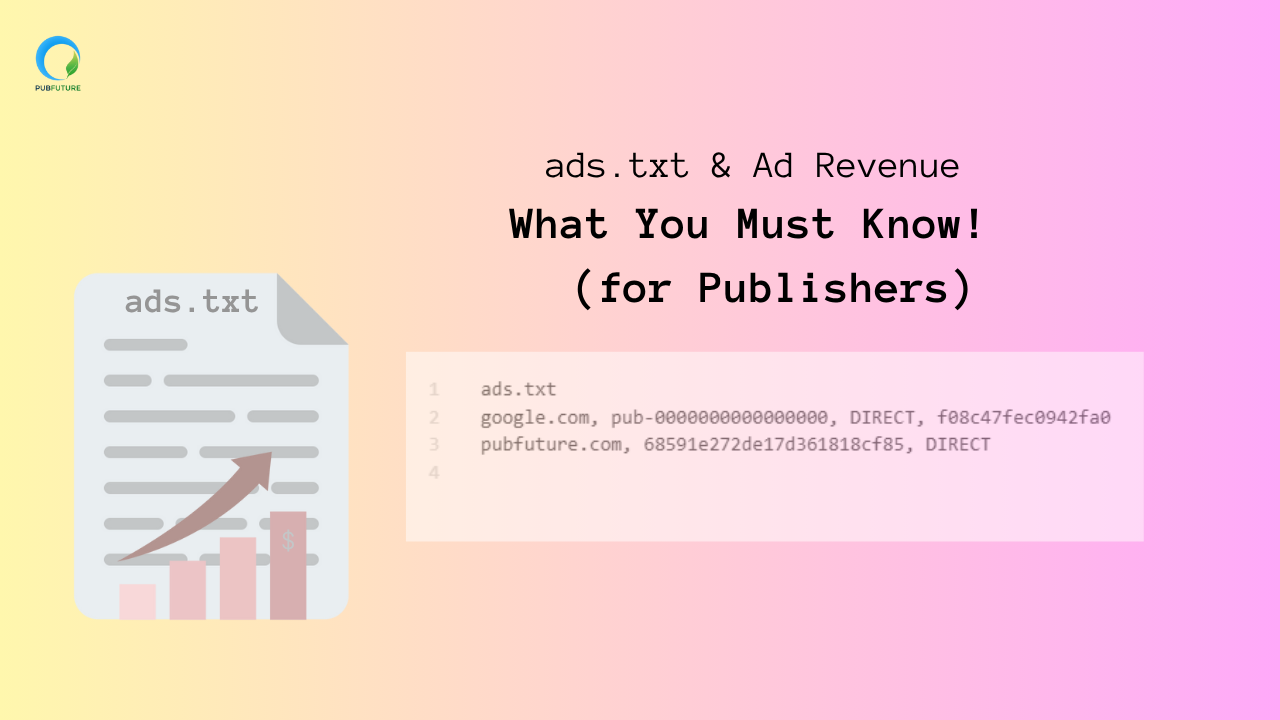If you’re a publisher monetizing through programmatic advertising, your ads.txt file might be doing more for your revenue than you think—or holding it back without you realizing.
At PubFuture, we help publishers increase their ad yield by connecting them with trusted, high-performing demand partners. A critical part of that process is ensuring your ads.txt file is accurate, complete, and optimized to allow the right buyers to bid on your inventory.
But we’ve found that many publishers either misunderstand how ads.txt works, forget to update it, or make common mistakes that quietly cost them real money.
In this guide, we’ll walk you through:
- What ads.txt actually does and why it matters
- How to fully optimize your ads.txt for better performance
✅ What Is ads.txt and Why It Exists
If you’ve ever wondered why you need to upload a simple text file to your website just to run ads, you’re not alone. Let’s break it down.
What is 📄 ads.txt?
ads.txt stands for Authorized Digital Sellers. It’s a publicly accessible file you place at the root of your website (like yourdomain.com/ads.txt) that lists all the companies authorized to sell your ad space.
Think of it as your “official seller list” — a way to prove to advertisers, ad exchanges, and demand partners that you’re working with trusted, verified sources.
At PubFuture, we rely on this file to help ensure our demand partners can identify your site as a legitimate source of inventory and confidently place high-quality bids.
🛡️ Why Was ads.txt Created?
ads.txt was introduced by the IAB (Interactive Advertising Bureau) to solve a serious problem in the industry: domain spoofing.
Here’s what was happening before ads.txt:
- Fraudsters were pretending to be real websites and selling fake ad space under your domain name.
- Advertisers unknowingly bought these fake impressions, wasting their budget.
- Honest publishers—like you—missed out on real revenue.
By using ads.txt, you prevent that. You’re telling the entire programmatic ecosystem: “These are the only partners allowed to sell my ad inventory.” This protects your reputation and ensures you get paid when advertisers bid on your site.
💡 Quick Example:
Let’s say you’re working with PubFuture and we’ve helped you connect to multiple trusted demand partners. If one of those partners isn’t listed in your ads.txt file, advertisers might skip over your inventory — even if your content is high-quality and your traffic is real.
That’s why keeping your ads.txt correct and up to date is more than just a technical step — it’s a key part of protecting and growing your ad revenue.
✅ How to Optimize ads.txt for Maximum Revenue
Uploading an ads.txt file is just the beginning. To get the full revenue benefit, you need to treat it as a living, revenue-critical document—not a set-it-and-forget-it task.
At PubFuture, we help publishers maintain healthy, optimized ads.txt files to ensure they capture every high-quality bid possible. We work with publishers across all sizes and verticals—and one thing is consistent: a clean, up-to-date ads.txt file is directly tied to stronger ad performance.
While uploading the file is the first step, real revenue growth comes from maintaining it proactively. Here’s how to get the most out of your ads.txt and make sure you’re never missing out on valuable demand.
🔄 1. Regular Updates = Continuous Revenue
Your list of demand partners changes. New partners are added, others become inactive, and IDs get updated. If you’re not reviewing your ads.txt file regularly, you’re likely blocking some of your highest-paying bidders—without even knowing it.
We recommend reviewing your ads.txt at least once per month or immediately after any partner or setup changes. PubFuture provides you with the correct lines during onboarding, and we’re always here to assist with updates.
Concerned about performance? Don’t be. ads.txt doesn’t affect page speed, SEO, or user experience.
🛠️ 2. Keep Formatting and Entries Clean
An incorrect format, outdated ID, or even a missing comma can render a line invalid. When that happens, the associated partner won’t be able to buy your inventory—even if you’re approved in their system.
Key tips:
- Follow this format exactly:
domain.com, publisher-ID, DIRECT/RESELLER, cert-ID
- Only list authorized and active partners
- Use a tool like ads.txt-validator.com to check for syntax errors
🧹 3. Remove Inactive or Risky Partners
If you’ve stopped working with a partner, remove their entry from your ads.txt. Keeping old or unauthorized sellers may reduce buyer trust and could even result in fewer bids from premium advertisers. Some buyers automatically downrank or avoid sites with bloated or low-quality ads.txt files.
⚠️ 4. Monitor Performance and Warnings
Always pay attention to any warnings from your SSP dashboards or Google Ad Manager. If you notice a drop in fill rate or sudden revenue dips, your ads.txt could be the culprit.
What to check for:
- Ads.txt-related errors in reporting dashboards
- Traffic but no impressions from key demand sources
- Demand partners requesting changes or re-authorization
💡 PubFuture Tip:
If you’re unsure about which partners to add or whether your ads.txt is fully optimized, our team will review it with you and make sure it is kept up-to-date. This ensures you’re open to every available bid, without risk or guesswork.
📈 Final Thought
Your ads.txt file might be a simple text document, but it directly impacts how much money you make. Keeping it current and clean is one of the easiest, most effective ways to protect and maximize your ad revenue—and it only takes a few minutes when done right. PubFuture is here to help. A quick audit or assistance updating your file—we’re happy to support your growth. Let’s start with the ads.txt implementation, and then we can explore the best potential revenue sources of the advertising industry together. You can reach our file here.









